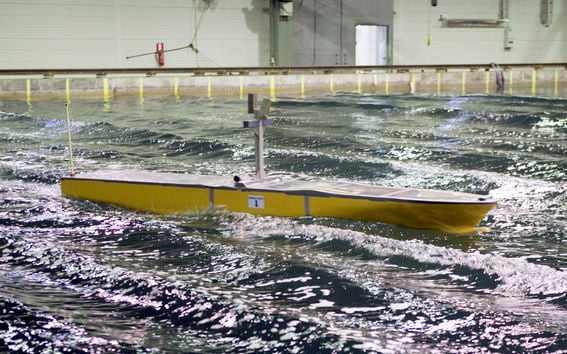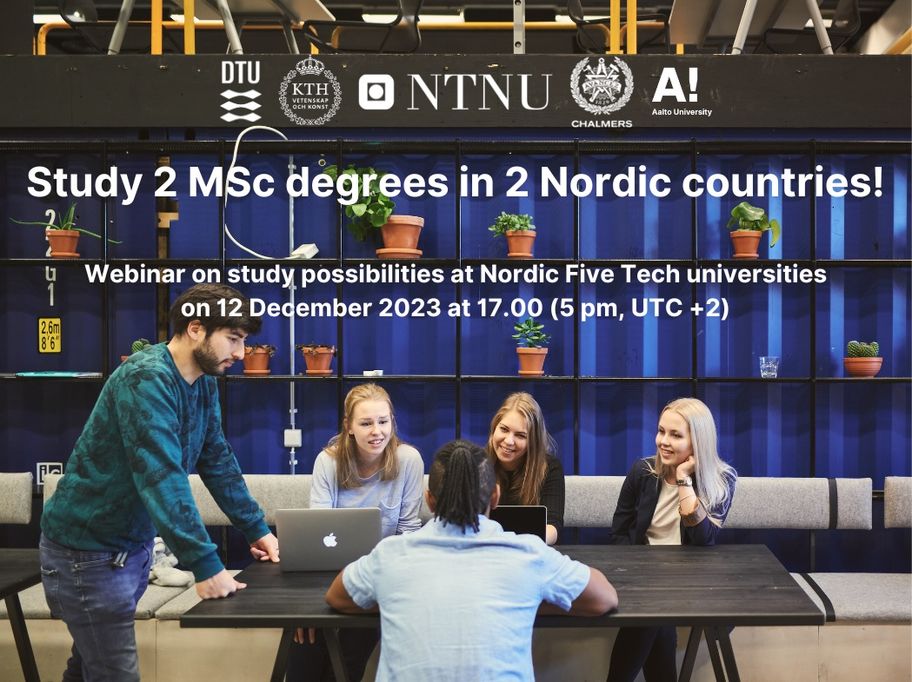Maritime Engineering (Nordic Master), Master of Science (Technology)

Tutkinto:
Hakuaika:
Opetuskieli:
Kesto:
Hakukelpoisuus:
Koulutusala:
Laajuus:
Korkeakoulu:
Koulutuksen kuvaus
Maritime Engineering -maisteriohjelman painopisteenä ovat alukset, mukaan lukien jahdit ja offshore-rakenteet, niiden suunnittelu, rakentaminen ja käyttö sekä vuorovaikutus ympäristön kanssa.
Opit soveltamaan matematiikan, numeerisen analyysin, nestemekaniikan ja rakennemekaniikan rationaalisia menetelmiä alusten ja offshore-rakenteiden analysointiin, suunnitteluun ja tekniseen käyttöön. Lisäksi ymmärrät näihin rakenteisiin kohdistuvat erityisvaatimukset, jotka koskevat esimerkiksi turvallisuutta ja ympäristön suojelemista.
Opetuskieli
Ohjelman opetuskieli on englanti.
Lukuvuosimaksut ja apurahat
Maksat lukukausi- ja muut maksut suoraan yliopistolle, johon olet ilmoittautunut opiskelemaan. Maksu vastaa kyseisen yliopiston maksutasoa.
Tällä hetkellä Aalto yliopisto, DTU, Chalmers perivät lukukausimaksuja EU/ETA-alueen ulkopuolisilta opiskelijoilta. NTNU ei peri lukukausimaksuja Nordic Masters oiskelijoilta.
Lue lisää yliopistojen verkkosivuilta:
Aalto perii lukukausimaksuja muilta kuin EU-/ETA-alueen kansalaisilta.
Chalmers perii lukukausimaksuja muilta kuin EU-/ETA-alueen kansalaisilta.
DTU perii lukukausimaksuja muilta kuin EU-/ETA-alueen kansalaisilta.
Nordic Master in Maritime Engineering -ohjelmaan ei liity erityisiä apurahoja.
Tietoja apurahoista sekä lukuvuosimaksuvapautuksista kumppaniyliopistoissa löytyy tarkemmin yksittäisten yliopistojen verkkosivuilta: Aalto, Chalmers, DTU
Opintojen rakenne
Ohjelma on jaettu kahteen osaan:
- Ensimmäisenä vuonna (Entry) opiskelet meritekniikkaa, laivanrakennusta ja offshore-tekniikkaa maisteritasolla: vakautta, kestävyyttä ja työntövoimaa, merikelpoisuutta, ohjaamista sekä laiva- ja merirakenteita. Jos kandidaatin tutkintoosi ei sisältynyt laivanrakennuksen opintoja, suoritat myös laivanrakennuksen peruskursseja. Meritekniikan kurssien lisäksi sinun tulee suorittaa yleisiä ja erikoistuneita teknisten alojen kursseja esimerkiksi sellaisista aiheista kuten CFD, rakenneanalyysi, komposiittimateriaalit jne. Kunkin aiheen painotus riippuu aloitusyliopistosta ja hakukelpoisuudestasi. Erityisesti Aalto mutta myös NTNU tarjoavat arktisen meritekniikan valinnaisia kursseja osana opetussuunnitelmiaan.
- Toisena vuonna (Exit) erikoistut yhteen neljästä aiheesta: merirakenteisiin, matkustaja-aluksiin, laivojen suunnitteluun tai alusten operatiiviseen toimintaan. Jokainen aihe on oma suuntautumisvaihtoehtonsa. Diplomityösi aiheen tulee olla opintopolun mukainen.
Suoritat opintojen ensimmäisen vuoden opinnot aloitusyliopistossa ja siirryt suorittamaan toisen vuoden opinnot toiseen yliopistoon eli ns. valmistumisyliopistoon.
Suuntautumisvaihtoehdot
Ocean Structures (NTNU)
Tämä suuntautumisvaihtoehto tarjoaa vahvan pohjan kaikenlaisten merirakenteiden suunnittelulle perinteisistä aluksista merellä oleviin rakenteisiin. Opinnoissa käsitellään myös merellä suoritettavia operaatioita kuten putkien asentamista, hinausta ja nostureiden käyttöä liikkuvilla aluksilla merenalaisia moduuleja asennettaessa. Opetus perustuu alan tieteelliseen tutkimukseen, ja siihen kuuluu erilaisia meriympäristöä käsitteleviä kursseja esimerkiksi ympäristökuormituksesta, kuormituksen vaikutuksista, rakenteellisesta kapasiteetista ja meriympäristön kybernetiikasta. Lue lisää kohdassa Study tracks
Passenger Ships (Aalto)
Tämä suuntautumisvaihtoehto antaa kattavan yleiskuvan matkustaja-alusten suunnittelusta, analysoinnista ja optimoinnista. Opinnoissa perehdytään eri sidosryhmien (matkustaja, laivanomistaja, telakka) keskenään ristiriitaisiin etuihin, ja opiskelijat pääsevät kehittämään sidosryhmien toiveiden mukaisia ratkaisuja. Lue lisää kohdassa Study tracks
Ship Design (Chalmers)
Tässä suuntautumisvaihtoehdossa olet osa projektitiimiä ja työskentelet ongelmalähtöisen ja realistisen alussuunnitteluprojektin parissa ”asiakkaanasi” olevan merenkulkualan yrityksen kanssa. Olet osa opiskelijatiimiä, jota ohjaavat alan ammattilaiset ja Chalmersin opetushenkilökunta. Projektin aikana käydään läpi asiakkaan vaatimuksia vastaavan aluksen alustava suunnitteluprosessi. Projekti toteutetaan toisen opiskeluvuoden aikana, ja pääset hyödyntämään ja yhdistelemään kaikkia ensimmäisen vuoden kurssien tietoja. Lue lisää kohdassa Study tracks
Ship Operations (DTU)
Lyhyesti sanottuna tässä suuntautumisvaihtoehdossa käsitellään pääasiassa laivanvarustajan näkökulmasta laivanrakennusta ja meritekniikkaa – eli merellä olevia aluksia. Opit soveltamaan järkeviä menetelmiä alusten (konttialukset, säiliöalukset, irtolastialukset, ro-ro-alukset jne.) suorituskyvyn analysointiin ja optimointiin turvallisuuden, tehokkuuden, taloudellisuuden ja ympäristöystävällisyyden näkökulmasta. Lue lisää kohdassa Study tracks
Kansainvälistyminen
Ohjelman henkilöstö tekee aktiivisesti tutkimusta ja on julkaissut lukuisia artikkeleita alan kansainvälisesti tunnustetuissa lehdissä sekä lukuisia oppikirjoja jatko-opiskelijoille. Lisäksi useat henkilöstön jäsenet osallistuvat kansainväliseen yhteistyöhön esimerkiksi Euroopan unionin rahoittamissa tutkimus- ja kehityshankkeissa.
Opetukseen kuuluu luentoja, seminaareja ja paljon projektityötä. Opetus tapahtuu läheisessä yhteistyössä alan yritysten kanssa, mikä mahdollistaa vierailut, vierailulennot ja täsmällisen projektityöskentelyn.
Kaikissa yliopistoissa on hyvät datakeskukset ja muut tietojenkäsittelytilat, joiden ansiosta opintoihin voi sisällyttää numeerista simulointia, mikä valmistaa sinua tulevaan teolliseen tai tieteelliseen työhösi.
Lisäksi jokaisella kumppaniyliopistolla on erityistiloja:
Jatko-opintomahdollisuudet
Nordic Masters in Maritime Engineering -maisteriohjelma tarjoaa erinomaiset valmiudet tohtoriopintoihin ja post doc -tehtäviin
Uramahdollisuudet
NMME-maisteriohjelmasta valmistunut diplomi-insinööri työskentelee usein esimerkiksi laivanrakennusinsinöörinä tai offshore-insinöörinä konsulttiyritysten, suunnittelijoiden, alusten omistajien, merenkulkuviranomaisten, offshore-yritysten, luokituslaitosten tai erikoislaitteiden toimittajien palveluksessa. Työnimike voi olla toimitusjohtaja, kehityspäällikkö, tiimipäällikkö, konsultti, asiantuntija tai tutkija.
Tutkimuksen painopisteet
Meritekniikka ja arktinen tekniikka
Keskitymme alusten ja rakenteiden käyttäytymiseen sekä tavallisissa ympäristöissä että ääriolosuhteissa. Tutkimusaiheitamme ovat merikuljetusten turvallisuus sekä meriympäristön risteilymatkustajille tarjoamat kokemukset.
Yhteistyö muiden toimijoiden kanssa
Nordic Five Tech -yliopistoilla on erittäin korkeat akateemiset standardit, ja ne ovat teknisten yliopistojen kansainvälistä huippua. Yliopistot tarjoavat opiskelijoille erinomaiset mahdollisuudet opiskella itseään kiinnostavia aiheita. Yhdistämällä resursseja Nordic Five Tech -yhteistyön kautta pystymme tarjoamaan opiskelijoille huippuluokan tiloja korkeakoulujen huippuosaamisalueilla.

Tule Nordic Master -webinaariimme joulukuussa!
Nordic Five Tech (N5T) -yliopistot tarjoavat viisi erinomaista yhteistutkinto-ohjelmaa energia-, ympäristö-, meri- ja arktisen tekniikan sekä polymeeritekniikan aloilla. Näissä ohjelmissa suoritat samalla kertaa kaksi maisterintutkintoa ja opiskelet kahdessa pohjoismaassa.
Tässä webinaarissa sinulla on mahdollisuus kuulla Nordic Master -yhteistutkinto-ohjelmien yksityiskohdista ja ja kysyä uramahdollisuuksista, opiskelijakokemuksista sekä hakuprosessista. Tule tapaamaan professoreita, alumneja, opiskelijoita ja hakijapalvelujen työntekijöitä webinaariimme 12.12.2023 klo 17.00 (Suomen aikaa). Webinaari pidetään englanniksi.
Katso ohjelman hakuohjeet, vaaditut liitteet ja arviointiperusteet ohjelman englanninkieliseltä sivulta.
- Julkaistu:
- Päivitetty: